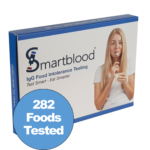If you’ve ever experienced a migraine, you know how painful, draining and debilitating they can be. Often coming out of nowhere, the impact of a bag migraine can last hours, and sometimes even days.
This Migraine Awareness Week (5 – 11 September) we’re taking a look at the link between diet and migraine, and whether what you eat can play a part in triggering an attack.
What is migraine?
Migraine is a severe and painful long-term health condition. If you have migraine you will have migraine attacks, which can involve the whole body.
During an attack, symptoms can include:
- Head pain
- Sensitivity to light, sounds or smells
- Problems with your vision, such as seeing flashing lights
- Tiredness and fatigue
- Feeling nauseous or being sick
Symptoms can vary from person to person, but for many, when an attack hits, it’s impossible to function normally.
Migraine attacks can last anywhere between four hours and three days and symptoms may present at different times, before or after experiencing head pain.
What causes migraine?
Doctors and scientists believe that migraine occurs when abnormal brain activity triggers certain nerve signals and chemicals in the brain. We don’t fully understand what causes this to happen, but genetics do play a part of many sufferers.
While there’s still a lot we don’t know about migraine, there are known triggers which can have an impact. These include stress, hunger, low blood sugar, hormones, alcohol, sleep deprivation and environmental conditions, such as temperature or lighting.
Can diet trigger migraine?
For many sufferers, diet can have a big impact on their migraine attacks.
Skipping meals or eating sugary snacks instead of a balanced meal can also result in an attack. Under eating is a common trigger so it’s important to eat health, balanced meals regularly. Adding in small, nutritious snacks can also help keep migraine attacks at bay.
For some, the additives or chemicals in certain foods can play a part in triggering migraine attacks. These include:
Aspartame, an artificial sweetener found in some foods and fizzy drinks.
Monosodium glutamate (MSG), a flavour enhancer often added to some foods, in particular Chinese food and processed meats.
Nitrates which occur naturally in some foods such as vegetables and are also added to processed meats such as bacon
Tyramine, which is found in red wine and soft cheeses like camembert and brie. Some people with migraine avoid red wine as they find tyramine can trigger migraine attacks.
Other dietary triggers – fact or fiction
Alcohol – fact
For most of us, drinking large amounts of alcohol will lead to a headache, one of the most common symptoms of a hangover.
But alcohol, even in small amounts, can also trigger migraine and cluster headache for people prone to suffering these attacks.
Not everyone who suffers with migraine and cluster headache find alcohol to be a trigger, and for some, only certain types of alcohol will have this effect.
Chocolate – fiction
In the early stages of an attack, it’s often quite common to crave something sweet. Eating chocolate might satisfy that craving but when the head pain begins, the chocolate will often get the blame. But the migraine started before that pain and the cravings were an early warning sign.
Caffeine – fact
For some people, too much caffeine, can lead to a migraine attack. However, cutting out caffeine suddenly can also cause problems. If you think caffeine may be a trigger for your migraine attacks, try and gradually reduce the amount you have, rather than going cold turkey.
It’s not just tea and coffee you need to steer clear of if you’re avoiding caffeine. Some fizzy drinks, as well as chocolate and some over-the-counter painkillers also contain caffeine.
What are the signs of a food intolerance?
Food intolerances, which can occur when your body’s immune system mistakes a food protein as a threat, releasing antibodies to fight it, can cause a host of inflammation.
Irritable Bowel Syndrome (IBS), bloating, low mood and joint pain are all reactions that can result from a food intolerance, as well as neurological complaints such as headache and migraine.
What are the signs of a food intolerance?
Food intolerances, which can occur when your body’s immune system mistakes a food protein as a threat, releasing antibodies to fight it, can cause a host of inflammation.
Headaches, brain fog, skin complaints like eczema or acne and joint pain are all reactions that can result from a food intolerance, as well as Irritable Bowel Syndrome (IBS) and bloating.
Keeping a diary
If you suffer with migraine and think something in your diet could be a cause, it could help to keep a headache diary. This can help keep track of your attacks and what you’ve had to eat or drink around that time.
If certain foods look like they could be a tricker, it could be worth trying an elimination diet, where you remove one food at a time for a few weeks to see how you feel. However, this process can take a long time. And, although many of us commonly react to a few different ingredients, the elimination diet is often abandoned when the first trigger food is found, leaving an incomplete picture of what’s causing the problem.
Get answers faster with Smartblood
When it comes to food intolerance testing, it’s important to do your research and choose a reputable laboratory testing company.
At Smartblood, we offer a comprehensive test to help you take control of your diet quickly and discover your own trigger foods.
Our home-to-laboratory service gives you fast, accurate results that pinpoint exactly which foods you are reacting to. Tests are completed in our accredited laboratory by trained experts, with clear, easy to understand results sent to you via email within three days.
Dedicated nutritional support
Importantly, our tests include a telephone consultation with our BANT registered Nutritional Therapist. This additional support is there to help you understand your results and put a plan together to make safe, sustainable changes to optimise your diet.




